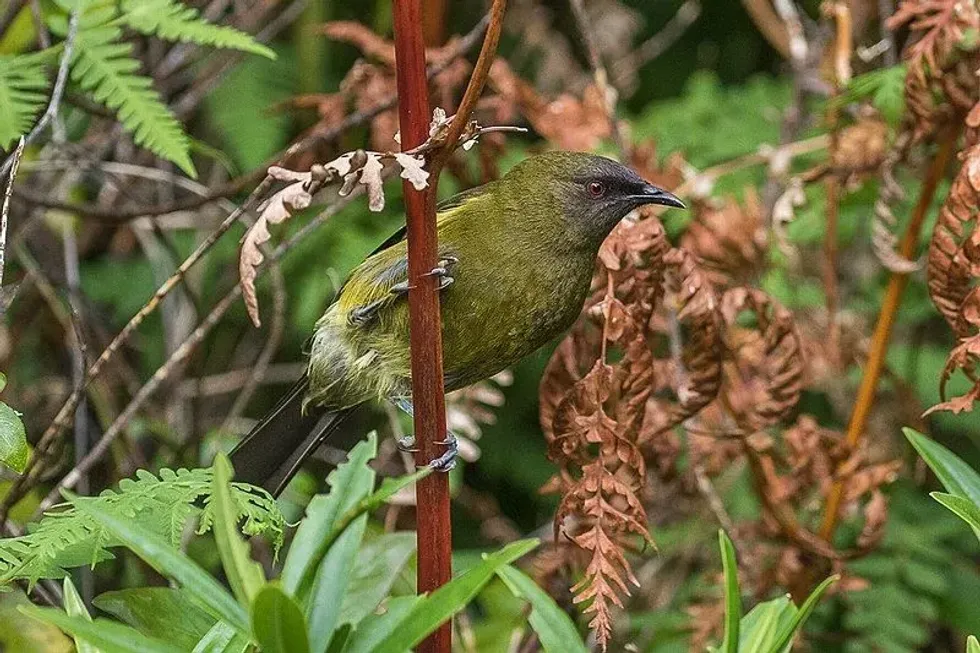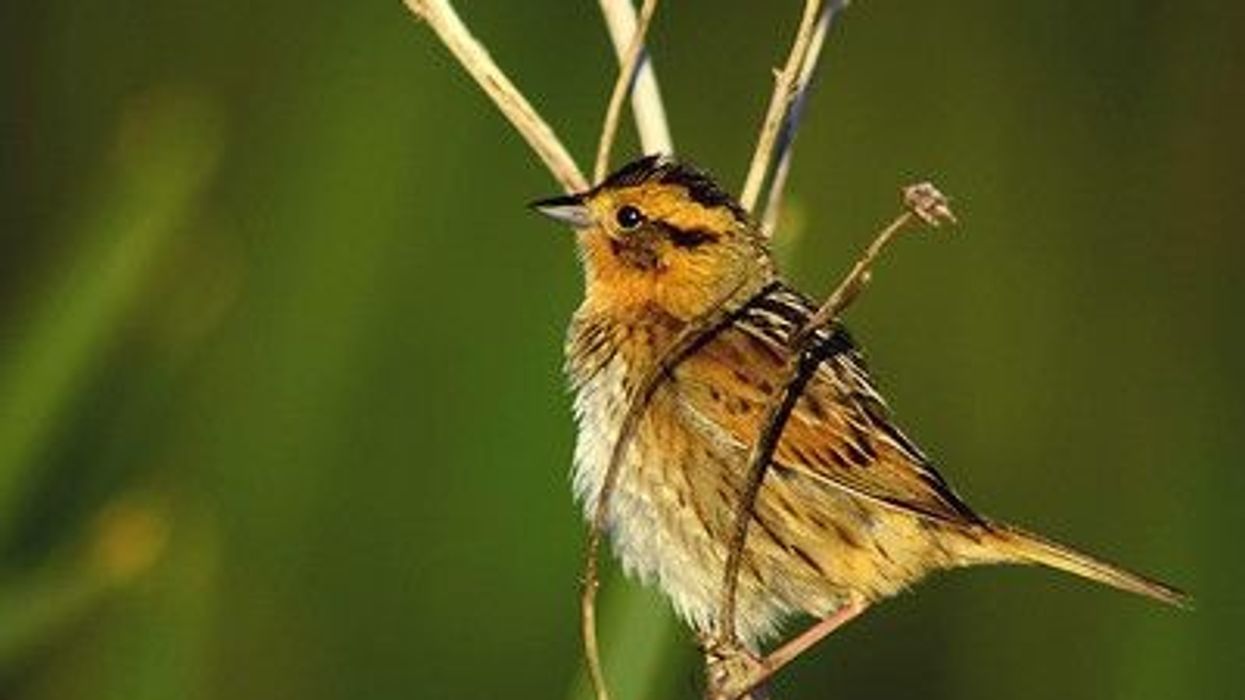New Zealand bellbirds (Anthornis melanura) are honeyeaters from the south and north offshore islands. They are also called korimako, makomako, mockie, and bellbirds. They are endemic to New Zealand.
Their singing and songs are music to our ears and is a welcoming tone song in mainland forests. Their tongue is brush-like, which helps them reach deep in flower to such the nectar. They also feed on fruits and insects. They sound like tui birds and are related.
New Zealand bellbirds (Anthornis melanura) play a crucial role in pollination. While feeding on fruits, they help in pollination, as they disperse seeds. Therefore, they greatly help in the regeneration of forests.
The New Zealand bellbird feeds on nectar from native plants and flowers. During the summer and autumn, they feed on fruit and flowers. They take honeydew from beech forests. Bellbirds also feed on insects and spiders by gleaning trunks, branches, and leaves. Their coloration includes olive-green to dark green, with a dark blue to black tail.
To learn more interesting facts about other birds species, you may also want to check out these red-backed shrike facts and umbrellabird facts.
New Zealand Bellbird Interesting Facts
What type of animal is a New Zealand bellbird?
Korimako birds are a type of bird from the genus Anthornis and are native to New Zealand.
What class of animal does a New Zealand bellbird belong to?
Korimako birds belong to the class Aves.
How many are New Zealand bellbirds there in the world?
The total population of the New Zealand bellbird across the world is unknown.
Where does a New Zealand bellbird live?
Korimako birds live in exotic forests, parks, gardens, farm shelters, scrubs, and islands.
What is a New Zealand bellbird's habitat?
This bird can be observed across Australia and nearby islands. They are widespread across Auckland Island, North Island, South Island, Stewart Island, and other islands as they seem to enjoy tropical and wet places. They are endemic to New Zealand.
Who do New Zealand bellbirds live with?
Korimakos fly alone but feed together with other bellbirds. They lead a solitary life most of the time, but they may be seen in groups or as a pair when feeding or breeding.
How long does a New Zealand bellbird live?
New Zealand bellbirds (Anthornis melanura) generally have a lifespan of around eight years or less.
How do they reproduce?
Bellbird's breeding season is spring and summer. They build a loose nest of foliage, twigs, and grasses, lined and outlined with feathers and grasses for breeding. These nests are mostly in dense cover not too high from ground level.
Female new Zealand bellbird calls attract male bellbirds. Females incubate up to five eggs while the males keep watch. Both parents, male and female, care for the fledgling as a family unit.
What is their conservation status?
Bellbirds easily survive on the mainland with predators. However, their population density is higher in predator-free islands.
The reason for the decline of these bellbirds from North and Auckland in the 1860s was the predators. There was a minimum of nine attempts to translocate bellbirds to islands or the mainland.
Their natural habitat has been on the decline due to European-style farming, which resulted in their population decline. The introduction of many predators like ferrets, rats, stoats, rodent families, and food robbers has resulted in the population decline. However, to protect them from predators like rats and stoats, attempts were made on the island and mainland.
After the early attempts of conservation, the population did not grow, but it automatically started growing rapidly due to some unknown reason in the natural environment. The conservation status of bellbirds throughout their range is of least concern.
New Zealand Bellbird Fun Facts
What do New Zealand bellbirds look like?

New Zealand bellbirds (Anthornis melanura) are olive green in coloration. They have a short and curved bill with a forked tail. The bellbird has a noisy whirring sound and flies direct and fast.
Males New Zealand bellbird is paler and olive green on the lower parts. It has a purple head, black wings, and tail. Females have white, yellow stripes across the cheek from the bill and are browner than males.
Males and females both have wine-red eyes. Chicks are more like females, but they have yellow cheek stripes and brown eyes.
They do not have bluish head gloss. They are common throughout their range. As adults, they have a total body length of around 6.6-7.8 in (17-20 cm) and weigh around 0.8- 1.1 oz (25-32 g).
How cute are they?
Korimakos are cute-looking members of the species and flock for food sources like nectar and flowers.
How do they communicate?
The singing notes and alarm call of the New Zealand bellbird (Anthornis melanura) has no wheezes. The alarm call is repeated 'yang' sound. They make the melodious song. New Zealand bellbird song is mostly heard during dawn and dusk. They sound like tuis.
How big is a New Zealand bellbird?
These birds have a total body length of around 6.6-7.8 in (17-20 cm), which is five times bigger than a flycatcher.
How fast can a New Zealand bellbird fly?
They can fly high in predator-free zones. After breeding, they fly alone but eat together.
How much does a New Zealand bellbird weigh?
These native birds of New Zealand generally weigh around 0.8- 1.1 oz (25-32 g).
What are the male and female names of the species?
There are no specific names used to describe the male and female of this bird species.
What would you call a baby New Zealand bellbird?
The young are called chicks.
What do they eat?
They feed on nectar, small invertebrates, and insects. They try to stay away from their predators like rats and stoats.
Are they dangerous?
No, these birds are not dangerous and do not pose any threat to anyone in any way.
Would they make a good pet?
No, they are wild birds so they should not be kept as pets, even though they are very cute!
Did you know...
The oldest New Zealand bellbird died at the age of eight years old.
Are New Zealand bellbirds endangered?
No, they are of Least Concern. In order to protect them from predators like rats and stoats, attempts were made to protect them on the island and mainland. After the early attempts of conservation, the population did not grow, but it automatically started growing rapidly due to some unknown reason in the natural environment.
How did the New Zealand bellbird get its name, and what other names does it have?
As a bird endemic to New Zealand and their voices like that of a ringing bell, they have been named New Zealand bellbird. The other names for them are korimako, makomako, mockie, and bellbird.
Here at Kidadl, we have carefully created lots of interesting family-friendly animal facts for everyone to discover! Learn more about some other birds from our ani bird facts and giant cowbird facts pages.
You can even occupy yourself at home by coloring in one of our free printable New Zealand bellbird coloring pages.









